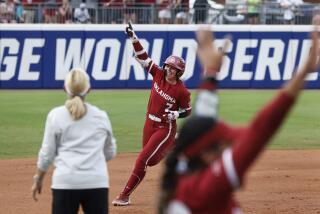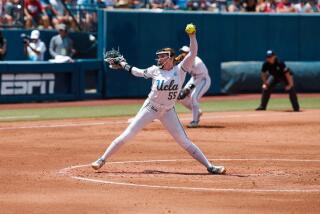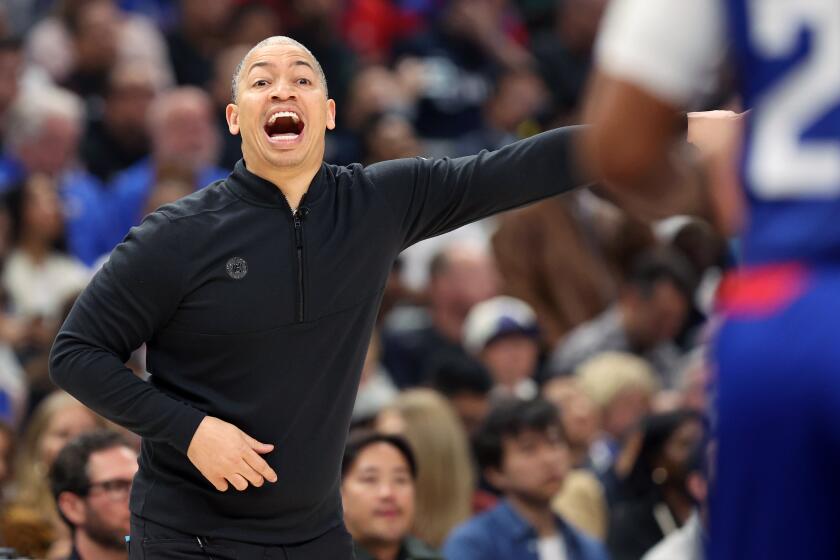For a Half-Century, Omaha Has Been the Gracious Host
- Share via
OMAHA, Neb. — Every June since 1950, fans from across the country have joined local baseball lovers at a little stadium just west of the Missouri River bluffs.
There’s little glitz or glamour, but that hardly matters. The crowds come to watch college baseball’s best and future major leaguers.
The College World Series has gone from a money pit that drew 17,805 in its first year in Omaha to a multi-million-dollar show. Attendance last year at Rosenblatt Stadium was a record 206,639 over the nine days.
“Omaha and the surrounding communities have taken this as kind of like our baby. It’s something that we’ve brought up and love to support,” said Jack Diesing Jr., president of College World Series Inc., organizer of the event that starts Friday.
While it might lack the pizazz of Miami or New Orleans, where college football national titles are often decided, NCAA baseball players and coaches only want to be in Omaha when the second week of June rolls around.
“It’s a perfect place because it’s been there for so many years. The whole area supports it so well and treats the teams great,” said Stanford coach Mark Marquess, who has taken 11 teams to Omaha and won the national championship in 1987 and ’88.
Despite being thousands of miles from most college baseball powers, teams and fans don’t seem to mind converging in the former frontier town known for steaks and rail yards.
The crowds are balanced by Nebraskans, who have had only one local team--Creighton in 1991--to cheer for in the CWS.
“Normally, there’s not a home favorite. It’s people who just support good baseball,” Marquess said.
And they’re supported by it, too.
Teams and fans spent around $11.3 million during the tournament last year, according to a study for the Greater Omaha Convention and Visitors Bureau. The overall economic effect on the city was estimated at $26.7 million.
Exposure for the CWS has only increased with TV coverage. ESPN started covering the tournament in 1980 with five games. The network began televising all games nationally in 1988, except for the championship, which CBS airs.
“It’s just something that sort of grew,” said Jack Payne, the public address announcer for the CWS since 1964.
Payne has seen all the Omaha championships except the first. He came to the city in 1951 as a broadcaster with WOW radio and television and watched the tournament evolve a long way from its 1947 debut in Kalamazoo, Mich. It stayed in Kalamazoo the following year, moved to Wichita, Kan., in 1949 before Omaha made a successful bid.
Although the tournament lost money in 10 of its first 12 years in Omaha, the city grew to embrace it.
“Over those years, when it was developing here, coaches took a liking to coming to Omaha. We were centrally located, had a great ballpark and our fans here are super,” Payne said.
Omaha Municipal Stadium, carved out of the top of a hill on the southeast edge of Omaha in 1948, was renamed in 1964 for former Mayor Johnny Rosenblatt, one of the early civic leaders who campaigned to bring the tournament to Omaha.
The stadium has gone from an original capacity of around 10,000 to 21,655. With standing-room tickets, the crowd at the championship game has topped 23,000 each of the past four years.
“It’s a national championship and it gave people in this area something to hang their hat on,” Payne said.
Nebraska, known primarily for the state university’s football team 50 miles down Interstate 80 in Lincoln, is also rich in baseball tradition.
Rosenblatt has been home to a minor league team since it was built. The Kansas City Royals’ Triple-A team plays there now.
The state has produced 114 major leaguers, according to the Museum of Nebraska Major League Baseball, including Hall of Famers Bob Gibson, Richie Ashburn and Grover Cleveland Alexander.
While none of them played in the CWS, many of the game’s current stars did, such as Albert Belle (LSU), Barry Bonds (Arizona State), Roger Clemens (Texas) and Nomar Garciaparra (Georgia Tech).
Pat Burrell (Miami), the 1996 CWS Outstanding Player and top overall draft pick in 1998, made his major league debut last month with the Philadelphia Phillies. Philadelphia manager Terry Francona was the 1980 Outstanding Player when he led Arizona to the CWS title.
“Even if you play professionally, it’s not the same. There’s not the ‘Rah, Rah’ atmosphere there is in the College World Series,” Marquess said. “The nice thing about Omaha is they make it special so the player is always going to remember.”
The tradition will continue for at least the next few years. Omaha and the NCAA have a contract through 2005 and a five-year option to follow.
The CWS continues to amaze Payne.
“Every year you just see it getting bigger and better--better than ever,” he said. “It’s a great show.”
More to Read
Go beyond the scoreboard
Get the latest on L.A.'s teams in the daily Sports Report newsletter.
You may occasionally receive promotional content from the Los Angeles Times.










